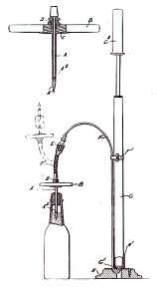12
Foundations
Long before "Cork Pops", "Pop-A-Cork" and "Corkmaster",
there were several cork ejectors. The earliest may have been
the invention of John Henry Aubrey Stapley of Crosby House,
Horley, Surrey, England. A corkscrew was a necessity in the
Stapley household but perhaps there was a day when Stapley
couldn't find his corkscrew. He likely studied his bottle of wine
carefully and thought if he could just expand the air between
the wine and the cork, the cork would be forced out and he
could quench his thirst. For his invention he took a hollow
needle and attached a handle to it. The needle protruded
through the handle with a provision to attach a hand pump. His
patent application drawing shows an ordinary bicycle type pump
looming three times as large as the bottle itself. He could then
simply force the needle into the cork, stroke the pump, and the
cork would be forced out of the bottle. Stapley cautioned "It is
desirable not to have too great a length of flexible tubing, in
order to prevent the cork on the needle whipping round to an undesirable extent when
it is driven out of the bottle." There's that "uncontrolled ejection" again! Stapley also
made the suggestion that the hollow needle be constructed like a corkscrew so once
the cork was removed partially by pressure, the rest could be drawn in the "ordinary
way." Stapley was granted English Patent No. 1,321 in 1914 and United States Patent
No. 1,140,082 in 1915.
The idea of a self-contained unit appears to have originated in
Switzerland in 1918. Pius Hasler in St. Gallen created a simple pump
in which the body of the device was shaped to fit the contour of the
bottle neck and once in place, lowering and raising a knob at the top
would inject the required air. Hasler was granted German Patent
314451 for his "
Vorrichtung zum Öffnen von Korkverschlüssen von
Flaschen mittels Luftpumpe
" on September 10, 1918. He would not get
his Swiss patent until January 16, 1919 (No. 79.938). During this same
time, Hasler also invented a parachute toy and a clasping device for
trouser suspenders.
In 1921 Hans Bauer in Frankfurt,
Germany, was working along the
same lines as Hasler with his
Pneumatischer Korkenzieher
. In his invention a needle
is passed between the cork and the bottle neck then
air is injected with a standard air pump. Bauer was
granted German Patent No. 357,928 on September
20, 1921.


